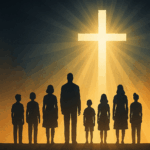
Text: Mark 16:1-8
Theme: The Empty Tomb (Series: 7 places, One story)
Sermon Tran
___________________________
SERMON TRANSCRIPT (Watch it here)
Intr – My friends in Christ, there’s a story about Good Friday, late afternoon.(It’s extra biblical, please don’t accuse me of heresy.) It’s a tale about Joseph of Arimathea coming to Pilate and asking for Jesus’ body to be removed from the cross, to be placed in an empty tomb.
Then Pilate would have said to Joseph: – Joseph, I don’t understand you. You are one of the most rich people around here, you are well off, you have carved this most pretty tomb for your entire family there. Why are you giving this to this Jesus?
Joseph would have said: -That’s okay, it’s just for the weekend.[1]
It’s just for the weekend! Christ is risen! He did not stay there. He did not stay there. The empty tomb is the reason we are here today, because if Christ had not risen from the dead, the Word would not have been going out, and Christianity would have failed just like any other small sect in that context. But the power of the news of that early morning, on that Sunday morning, is that the Master who was nailed to a cross is now living. He just stayed for the weekend. He’s out, he has killed death, and now that empty tomb brings hope to you.
We have been following during the Lent “Seven places, one story.” It’s a series of sermons we had on Mid-Lenten services. We started with Jesus in the garden, then the yard where Peter denied him, the tribunal, the unfair trial. Then we went to the streets of Jerusalem, then to the cross, last Maundy Thursday, in the upper room, where Jesus gives us Holy Communion. And today, the final of them. Final spot, the final stop for our series, by the empty tomb.
In all the other places, you see things happening in front of you, and you believe it. You believe that Judas betrayed Jesus, that Peter denied him, that he was on the streets bearing his cross, that he was nailed to a cross. Now here, you come to a place where you believe in what you don’t see, right?
The disciples and those ladies, they come early morning. The stone is removed. They look and see, and the Bible says, and they believe, and they believe in what? What they don’t see. The tomb is empty. Jesus is back to life.
The empty tomb has at least three things we want to think about today that are important for us.
1 – A Historical Place
The first one is that it is a historical place. It actually happened in Palestine, in Jerusalem, around Jerusalem, that this man, Joseph of Arimathea, had a tomb that he carved on the stone, and then he offered it for Jesus to be placed in there. Of course, it’s a tale he didn’t know yet, or perhaps he didn’t realize that Jesus was going to stay just for the weekend, but that’s what happened. But it’s an actual place, historical site.
And think about this detail: the Gospels mention that it’s a new tomb. Nobody was laid there before. So that’s crucial to reinforce the truth that Jesus was laid there and was out of it, because if it was an old tomb that other people were laid there, people might get confused. “Are you sure it’s this one? Maybe it’s that one. Maybe it’s that one.” No, there’s just one tomb around there that was empty, and nobody has ever occupied it. Somebody occupied it, and now he’s out of that tomb.
So Jesus, historically, is as important as his Bible, as his word. Sometimes we may get caught into the argument or the attempt of saying, you know, “It doesn’t matter, let’s not discuss history. The most important thing is Jesus’ message of love and care.” Both are equally important because what Jesus came to do as a human God, it’s part of his message. It’s interwoven with what he preached and taught. That is what he did.
He went to a cross. He came out of a tomb. He healed people, everything. So everything that he does in place and in time and in Palestine 2,000 years plus ago, this is as important as what he taught you and what we learn from him, from his sacred book.
The first thing of all to be grounded on then is that this is a historical fact, a historical place, a historical Jesus. He was there, and he was not anymore.
2 – A Foundational Place
The second thing is that this is a foundational place. Paul says in 1 Corinthians, we didn’t read the whole chapter, but later on in 1 Corinthians 15, our reading for today, he says, “if Christ is not risen, your faith is in vain.” That’s why I opened (our Service today) by saying that this is a powerful witness of your faith because you are here today to acclaim the Christ risen. Because if Christ remained dead on a cross, or if his body was stolen as some stories were circulated, or his disciples did something, and everything we are doing here, let’s pack up and go home and do something else, it all loses sense. In a sense, you cannot be a Christian if you don’t stand by the resurrection, because then your Christ is dead. He didn’t kill death. But what we know is that Christ, as Paul would say in some other text, swallowed up death.
Isn’t that ironic and contrasting? Remember the reading from Isaiah about this big banquet that the Lord will give to all the nations with all this rich food? Meanwhile, we are thinking about the fact that Jesus swallowed death. How bitter that was. But that was in our place. So this is very foundational to our faith, that we believe in what we don’t see. And because we don’t see, we believe.
I want to illustrate that for you. And I have here, I brought with me some headphones. This is a Wi-Fi headphone that I wanted to use with somebody…. what? is this not wireless? Isn’t this Wi-Fi? No, because you can see the cable, right? You would only believe in me that this is Wi-Fi if you didn’t see the cable. If it was just the phones, without this part, then you would believe in me.
In daily life, sometimes we believe when we don’t see stuff. Much more here. When we don’t see Jesus in the tomb, that He’s out of it, that He’s alive, that’s where our faith is grounded. Because faith, Hebrews 11 will say, is the certainty of the things that we don’t see, but that we believe and have in our hearts. B not seeing Jesus in the tomb, the disciples started to connect the dots. And the empty tomb is also a place to connect the dots.
Remember when Jesus sometimes said some things and the disciples didn’t understand Him well? Later on, then the evangelists say this, they didn’t understand this until Jesus came back from the dead. Sometimes we learn things just in retrospect, right? It’s only when you look back and you start to connect the dots and you see, oh, this is why God did this, and this is why God allowed that, and this is why I did this, or God did not allow me to do certain things. And then you start to connect the dots and make sense of the things that God has placed in your life.
This is what happened on Easter morning. The disciples, the ladies, and everybody else started to connect the dots and see Christ’s actions one by one, culminating on that day. So they were sure when they saw the empty tomb, “aha, this is what He said. He’s not dead. He’s alive!”
3 – A place of Life and Hope
And this is a place of life and hope.
I just said that Jesus “swallowed death.” Death is our worst enemy. We don’t like to think about it. But when we stand by the empty tomb, we are reminded of the life that Christ gave to us. This is especially significant. Jesus standing by the empty tomb is the fact that we see life right there. So when we stand before the grave of our loved ones, we can say the same thing as the tale tells. Not that it’s just for the weekend. When we are grieving somebody we lost, we can say, “this is just for some time. This is temporary.” One day we all will be raised and we will live forever. We will be with the Lord.
The empty tomb is a place of life and is a place of hope, a hope that carries us through in this world, a world filled of difficult circumstances, things that we don’t like, but we have to power through.
That’s when we look to Jesus, to the empty tomb and remember, my Lord is not a dead Lord. My Lord is a living Lord. So much so the tombs of many important leaders of the past, you can go and visit them. There’s no way you can know exactly where the place that Jesus was buried is. There are some places that in Palestine that they repute to be the place, but a hundred percent sure nobody is because he didn’t stay there. It’s not important to be in the place there. It’s important to know that he is with us right here where we are, bringing the same life and the same hope that he brought to those disciples, that the life that he brought to us is a life that doesn’t end on the grave. It goes beyond. We will have that banquet from Isaiah in heaven with all of our loved ones, way ahead of us, and then we will all be together to celebrate it.
So this is how we live our life as Christians. We live believing in what we don’t see because we have this hope. We have this life. We have the assuredness in Christ. All those places in Palestine, the seven places and many more, they all shaped Christ’s story and they shape our story. All those places are important because from there we receive Christ’s message of redemption and salvation and life and hope.
Conclusion – As a closing, I came across these lines from the murder scene on Julius Caesar. The assassins are washing their hands in Caesar’s blood. Then Cassius says,
“scoop then and wash how many ages hence
shall this our lofty scene be acted over
in states unborn and accents yet unknown.”
And then Psalm 22:30,
“posterity shall serve him.
It shall be told of the Lord
to the coming generation.”
From those places in Palestine so many years ago, the story kept going to states unborn, to accents yet unknown then, but known now because it shall be told of the Lord to the coming generation. Those same places are being told today and will be continued to be told so because those places, they tell the story that is foundational to us.
Places that shape our life there and shape our places in life here, our highs and our lows and everything in between, especially when we encounter the unexpected in those places, just like it was unexpected to find hope and life in front of a grave, in front of a tomb. Easter talks to us about an empty place, an empty place filled with hope and glory in life.
Not just for this weekend. For every day of our lives. Amen.
_______________________________
[1] https://www.instagram.com/p/C5D74jGrVOF/
AI Image generated with Gencraft









